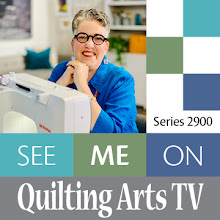Here is “Fall Farm Stand,” my latest piece, hanging on the wall, nice and flat, and from a single nail. To do this, I used a technique I developed while working on pieces for last year’s Fiber Art Options’ exhibition, “Orchids: Sensuality Stitched.” Several members of our group used this technique, which we had seen others use, and we all did it slightly differently. Here’s how I do it.
First, I measured my finished piece; it was 31-1/2" wide by 23" long. I cut a piece of black fabric the same as the width and about 2/3 of the length: 31-1/2" x 15". Then I finished all the edges by folding under 1/4", then 1/4" again, and stitching. This shows the back of the sleeve:
And this shows the right side of the back and the front:
I positioned this piece of fabric, finished side up, to the top of my finished quilt, about 1/2" from the sides and the top, and pinned it in place. Then I measured about 1/3" of the way down from the top of the finished quilt, and made two chalk marks about an inch apart on both the left and right sides. (You can see them right under the pin at the top of this photo.)
This is where the wire attached to the foam core will come out, so there needs to be an opening. I stitched the fabric sleeve down to the finished quilt, sewing up the side, across the top, and down the other side, leaving the openings on the left and right sides open:
I cut a piece of foam core to the correct size, slightly smaller in width than the width of the sleeve, and nearly the length of the finished quilt, minus a few inches. (Check to make sure that your foam core fits snugly, but does not stretch the quilt or the sleeve. If it is too tight, cut it down a bit more.) Next, I used Artists' Tape (which is acid free, and white) to finish all the edges cleanly, for a nicer presentation:
I then inserted the foam core into the sleeve, and marked the sides with a dot, right in the middle of the openings on both sides:
After pulling the foam core out of the sleeve, I marked the same spot on top of the foam core:
I used a heavy needle (you could also use a nail or an awl) to punch a hole through the foam core:
I reinforced both sides of the foam core with more Artist's Tape, and re-did the hole:
I measured two lengths of wire about the same width as the piece. On each side, I drew it through the hole about 1/3 of the length of the wire, knotted it, and then twisted the rest along the length of the rest of the wire:
Next, I inserted the foam core into the sleeve, and pulled the wires through the gaps in the sleeve. I pulled the wires from both sides into the center and knotted them, leaving a little “give” and not pulling it too tight, then twisted the rest of the loose wire along the other wire. Here’s how the back looks:
If you are going to be showing your work in traditional quilting venues, it is easy to create the 4" sleeve necessary for them. Just add about 4" extra to the length of the fabric piece, and after finishing all the edges, fold under the 4" at the top, and stitch it down from left to right. Then sew on the sleeve in the same manner I described. This way, it can hang either from a nail or from a rod.
I also think that hanging a piece in this manner helps it to look more like art, and less like a quilt, if that is what it is.






























